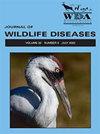荷兰北部冰川狐猴的高致病性禽流感。
IF 1.2
4区 农林科学
Q3 VETERINARY SCIENCES
引用次数: 0
摘要
我们报告2024年1月和2月在荷兰发现的10只北方狐猴(冰川狐猴)死亡的高致病性禽流感H5病毒感染。5只禽鸟感染了H5N5亚型,值得注意的是对哺乳动物的适应标记。对野生鸟类进行持续的传染病监测仍然很重要。本文章由计算机程序翻译,如有差异,请以英文原文为准。
Highly Pathogenic Avian Influenza in Northern Fulmars (Fulmarus glacialis) in the Netherlands.
We report highly pathogenic avian influenza H5 virus infection in 10 Northern Fulmars (Fulmarus glacialis) found dead throughout January and February 2024 in the Netherlands. Five birds were infected with the H5N5 subtype, notable for markers of adaptation to mammals. Continuous infectious disease surveillance remains important in wild birds.
求助全文
通过发布文献求助,成功后即可免费获取论文全文。
去求助
来源期刊

Journal of Wildlife Diseases
农林科学-兽医学
CiteScore
2.70
自引率
0.00%
发文量
213
审稿时长
6-16 weeks
期刊介绍:
The JWD publishes reports of wildlife disease investigations, research papers, brief research notes, case and epizootic reports, review articles, and book reviews. The JWD publishes the results of original research and observations dealing with all aspects of infectious, parasitic, toxic, nutritional, physiologic, developmental and neoplastic diseases, environmental contamination, and other factors impinging on the health and survival of free-living or occasionally captive populations of wild animals, including fish, amphibians, reptiles, birds, and mammals. Papers on zoonoses involving wildlife and on chemical immobilization of wild animals are also published. Manuscripts dealing with surveys and case reports may be published in the Journal provided that they contain significant new information or have significance for better understanding health and disease in wild populations. Authors are encouraged to address the wildlife management implications of their studies, where appropriate.
 求助内容:
求助内容: 应助结果提醒方式:
应助结果提醒方式:


